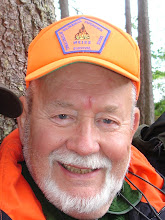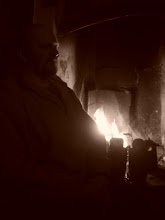
Wednesday, 30 January 2008
Bearclaw Supports........
The Bearclaw Bushcraft team like to support charity when applicable and as such we would urge all the Blog readers to visit the website below and make a donation - no donation is to small and it all goes to a great cause.


Friday, 25 January 2008
Fjallraven 30L Vintage sack
The new Fjallraven Vintage 30l rucksacks have arrived.
These are exactly the same as the 20l rucksacks just .....................bigger by 10litres but that ten litres has turned a humble rucksack which would comfortably hold a weekends kit or a weeks worth if packed with care into a Tardis which seems to swallow kit!!
Having tested the 20l all last year and having grown to love it and use it as my main sack I cant wait to get the 30l on my back.
The Fjallraven Vintage 30l is available in both green or khaki and will soon be added to the website but in the mean time well done to Fjellraven for listening to our advise and for producing a traditional looking yet highly functional rucksack thats perfect for almost all our bushcrafting needs!
Visit the bearclaw website for specs and prices ect!!
These are exactly the same as the 20l rucksacks just .....................bigger by 10litres but that ten litres has turned a humble rucksack which would comfortably hold a weekends kit or a weeks worth if packed with care into a Tardis which seems to swallow kit!!
Having tested the 20l all last year and having grown to love it and use it as my main sack I cant wait to get the 30l on my back.
The Fjallraven Vintage 30l is available in both green or khaki and will soon be added to the website but in the mean time well done to Fjellraven for listening to our advise and for producing a traditional looking yet highly functional rucksack thats perfect for almost all our bushcrafting needs!
Visit the bearclaw website for specs and prices ect!!
Wednesday, 23 January 2008
Down still not out
 For a long time down sleeping bags and clothing have existed, but for the bushcrafter the fear of the insulation lose which can happen if the down gets wet has always put people off.
For a long time down sleeping bags and clothing have existed, but for the bushcrafter the fear of the insulation lose which can happen if the down gets wet has always put people off.But because of its insulation qualities, its warmth to weight ratio and its general user friendliness the Bearclaw team have been trialing different down items over the last year.
Sleeping bags - in my youth, as a young soldier we were all issued the good old 58 pattern down bag and for at least 7 years I used one of these sleeping in trenches, ditches, under bashas and in tents, I have slept in a 58 bag which in the morning was covered in a layer of ice and looking back never seem to remember them letting me down - indeed with the water proof base and hood I remember many a time sleeping under the stars and when it started to rain simply rolling over so the bottom became a water proof top!!
So impressed with these bags am I that I now sleep in one still on all our expedition style courses. Their only down (excuse the pun) side is the bulk - being designed to roll into their own hood.
For courses when we're a foot and need to pack compactly I personally now favour the Fjallraven Distance P5 sleeping bag, this bag packs down to the size of a grape fruit, weighs next to nothing and is remarkably warm for its size - comfort rated only to 4c I've used my bag year round and using common sense (i.e sleeping in some of my clothes ect in really cold conditions) I've never had a problem with it. Indeed it is now my favourite of all bags!!
Another bag which has found favour with the team is the Alpkit Dream 500 - I personally have one but have never used it as the Distance P5 suits my needs but I know JP likes his. One thing with the Alpkit kit is the bivi bag while good quality is a little shy on volume being a broad shoulders chap I find them very confining to the point of actually being unusable!
Now onto down jackets, I dont know what it is about a down jacket but their is a comfort level which comes with these which is far more than just the jackets cut. The down itself seems to self regulate and thus far I seem to found that the jackets I've tried never seem to over heat?? Again weight and pack size is excellent. Going back to our fear of the lose of insulation in the wet - how many people go out into the woods without a waterproof jacket, poncho or ventile smock??
OK, ok maybe your one of the few, or your just unlucky and caught out without one, well the Montane Anti-freeze down jacket has a waterproof shell!! Simple!
Down jackets are the ideal thing for dry cold with out a shadow of a doubt, but our trials have found they hold their own in typical uk weather too ...................
As for the cost - well yes down is more expensive than most other insulation materials and that may inhibit some people - but look at it this way, your clothing is your first line of defence in the wilderness, if dressed correctly, for the temperature range and weather conditions you could survive many days without shelter, fire or a cutting tool - now consider how much you'd happily spend on a knife?? Suddenly down isnt so expensive.................
Lastly - another interesting thing I've found with down is you dont get the clammy feeling often found in synthetic bags or clothing!! Down may not be for everyone but its worthy of consideration - me and the boys are definate converts back to this simple, more traditional material and thats because we've found it works!
LOOK AFTER YOUR DOWN CLOTHING OR SLEEPING BAG AND IT'LL LOOK AFTER YOU.
Sunday, 20 January 2008
Camp kitchen
Much has been written about the best knife or jacket or rucksack for bushcraft but little if anything is written about the humble cook pot or stove!!
For many a billy can is best - but ask them why and they dont know - or they will answer "it can be hung over the fire" - so in essence they limit themselves to this one pot because they lack the skills or fire management, Granted a Swedish Army Mess kit is highly versatile and serve as many pots rather than one but even that may not be good enough.................
Imagine your kitchen at home. Do you cook everything in one saucepan? Or do you use a frying pan, a saucepan and a kettle??
So why do we feel we need to limit ourselves in the field??
In Lars Falts book FRILUFTSBOKEN and in Woodcraft by Nessmuk we see that a small kettle and a frying pan are incredibly versatile. Soldiers in the jungle are often taught to carry a frying pan as its a better cooking pot for that enviroment - why?

A pan or pot with a large flat surface area heats up the cooking materials quicker and more evenly - it requires the cook to stir the contents to stop them burning but for speed of warming a ration pack meal or boiling water a frying pan works amazingly well - saving fuel and time!! Remember a frying pan can fry, boil and be used for roasting or as a hot plate for bannocks and breads ect
 But maybe boiling water in a frying pan isnt the ideal answer - after all what if you want a brew with your stew - well here the small camping kettle comes into its own - something like a trangia 27 or the Gelert camp kettle which has a folding bail arm can be used to boil water on a stove or hung over the fire - it can be used as a billy can too - Lars Nilson has a good picture in his book of him boiling a couple of fish in his kettle! And in Sweden the coffee pot is never far from the fire ......lets also remember the oldest name for a cooking pot hung over the fire is kettle, or a translation of that.
But maybe boiling water in a frying pan isnt the ideal answer - after all what if you want a brew with your stew - well here the small camping kettle comes into its own - something like a trangia 27 or the Gelert camp kettle which has a folding bail arm can be used to boil water on a stove or hung over the fire - it can be used as a billy can too - Lars Nilson has a good picture in his book of him boiling a couple of fish in his kettle! And in Sweden the coffee pot is never far from the fire ......lets also remember the oldest name for a cooking pot hung over the fire is kettle, or a translation of that.
And then what about our stove - gas or Multifuel stoves can be expensive and the fuel doubly so - they also require you to carry in the fuel and containers and once used require you to carry out the empty containers ... and as a backwoodsman surely we'd rather cook on the open fire anyway??
 So why not look at something simpler - a hexi stove or a Tommy cooker as their known for example these are cheap - the fuel blocks can be used as tinder for fire lighting as we'll as with the stove and once used their no rubbish to carry out.
So why not look at something simpler - a hexi stove or a Tommy cooker as their known for example these are cheap - the fuel blocks can be used as tinder for fire lighting as we'll as with the stove and once used their no rubbish to carry out.
Another consideration for our cookware and stoves is size and effeciancy - a frying pan can sit happily at the back of a ruck sack taking up no room unlike say a Zebra billy can with its useless fold down bail arm that sticks out awkardly.
And something like a Tommy cooker has very few working parts to break and the blocks burn well in most temperature ranges unlike gas or white fuel ...........
Of course the above ideas may not suit everyone - the light weight camper might be happy with just a crusader cup and cooker - or the scout leader who has to feed a pack might want a big double burner ect - but persoanlly speaking I dont think we should be blinkered by convention or limit ourselves in our solo kits to what we think looks bushcrafty - try something new, see what you think!!
And remember a good meal and a hot drink are pricelss in the field, lifting morale and marking the end of pleasant days in the bosom of nature their second only in importance to a good nights sleep - so why skimp!!
For many a billy can is best - but ask them why and they dont know - or they will answer "it can be hung over the fire" - so in essence they limit themselves to this one pot because they lack the skills or fire management, Granted a Swedish Army Mess kit is highly versatile and serve as many pots rather than one but even that may not be good enough.................
Imagine your kitchen at home. Do you cook everything in one saucepan? Or do you use a frying pan, a saucepan and a kettle??
So why do we feel we need to limit ourselves in the field??
In Lars Falts book FRILUFTSBOKEN and in Woodcraft by Nessmuk we see that a small kettle and a frying pan are incredibly versatile. Soldiers in the jungle are often taught to carry a frying pan as its a better cooking pot for that enviroment - why?

A pan or pot with a large flat surface area heats up the cooking materials quicker and more evenly - it requires the cook to stir the contents to stop them burning but for speed of warming a ration pack meal or boiling water a frying pan works amazingly well - saving fuel and time!! Remember a frying pan can fry, boil and be used for roasting or as a hot plate for bannocks and breads ect
 But maybe boiling water in a frying pan isnt the ideal answer - after all what if you want a brew with your stew - well here the small camping kettle comes into its own - something like a trangia 27 or the Gelert camp kettle which has a folding bail arm can be used to boil water on a stove or hung over the fire - it can be used as a billy can too - Lars Nilson has a good picture in his book of him boiling a couple of fish in his kettle! And in Sweden the coffee pot is never far from the fire ......lets also remember the oldest name for a cooking pot hung over the fire is kettle, or a translation of that.
But maybe boiling water in a frying pan isnt the ideal answer - after all what if you want a brew with your stew - well here the small camping kettle comes into its own - something like a trangia 27 or the Gelert camp kettle which has a folding bail arm can be used to boil water on a stove or hung over the fire - it can be used as a billy can too - Lars Nilson has a good picture in his book of him boiling a couple of fish in his kettle! And in Sweden the coffee pot is never far from the fire ......lets also remember the oldest name for a cooking pot hung over the fire is kettle, or a translation of that.And then what about our stove - gas or Multifuel stoves can be expensive and the fuel doubly so - they also require you to carry in the fuel and containers and once used require you to carry out the empty containers ... and as a backwoodsman surely we'd rather cook on the open fire anyway??
 So why not look at something simpler - a hexi stove or a Tommy cooker as their known for example these are cheap - the fuel blocks can be used as tinder for fire lighting as we'll as with the stove and once used their no rubbish to carry out.
So why not look at something simpler - a hexi stove or a Tommy cooker as their known for example these are cheap - the fuel blocks can be used as tinder for fire lighting as we'll as with the stove and once used their no rubbish to carry out.Another consideration for our cookware and stoves is size and effeciancy - a frying pan can sit happily at the back of a ruck sack taking up no room unlike say a Zebra billy can with its useless fold down bail arm that sticks out awkardly.
And something like a Tommy cooker has very few working parts to break and the blocks burn well in most temperature ranges unlike gas or white fuel ...........
Of course the above ideas may not suit everyone - the light weight camper might be happy with just a crusader cup and cooker - or the scout leader who has to feed a pack might want a big double burner ect - but persoanlly speaking I dont think we should be blinkered by convention or limit ourselves in our solo kits to what we think looks bushcrafty - try something new, see what you think!!
And remember a good meal and a hot drink are pricelss in the field, lifting morale and marking the end of pleasant days in the bosom of nature their second only in importance to a good nights sleep - so why skimp!!
Friday, 11 January 2008
Saturday, 5 January 2008
We bring you snow
As the promised snow never arrived - lets go where it is!!
http://smg.photobucket.com/albums/v342/bearclaw/?action=view¤t=cold2.flv
http://smg.photobucket.com/albums/v342/bearclaw/?action=view¤t=cold2.flv
Subscribe to:
Comments (Atom)























